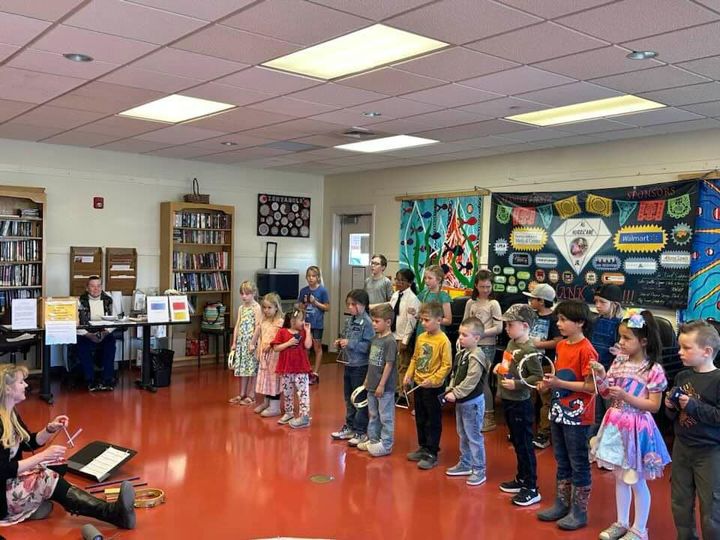|
Archuleta Seniors Inc is thrilled to announce the 2024 Older Americans Month (OAM) theme – "Powered by Connection." Led by the Administration for Community Living (ACL), this annual observance aims to recognize and honor the valuable contributions of older Americans. The chosen theme emphasizes the profound impact that meaningful relationships and social connections have on the health and well-being of our elderly population. This year, Archuleta Seniors Inc. is proud to join the nationwide celebration by hosting a series of events throughout May in Archuleta County.
By coming together and creating a network of support, we can ensure that the celebration of Older Americans Month goes beyond the confines of May. These events are not just about a month-long celebration; they are about building lasting connections, understanding the needs of our older community members, and empowering them to lead fulfilling lives. Join us in making May a month of joy, shared experiences, and strengthened connections. Together, we can make a lasting impact on the well-being of older Americans in our community. Questions or for more information please contact Archuleta Seniors Inc. at 970-264-2167. Shout out to the young students from Archuleta School District and their teachers and parents who stopped by the Pagosa Senior Center today to serenade the seniors with songs and handmade cards. Thanks for showing our seniors some love #intergenerational
Community members are encouraged by Archuleta Seniors, Inc. (ASI) to provide feedback on the needs of local older adult residents and to comment on how well ASI is meeting these needs. Several focus group discussions and an online survey are part of a countywide effort to gather data that will inform the ASI Board of Directors as it plans for ASI’s senior services provision for the coming three years. “We want to hear from anyone and everyone interested in maximizing the services and supports available to our community’s seniors,” says ASI Executive Director Rose Chavez. “It is important that all impacted voices are heard. To this end, we are hosting several focus group conversations, and are making the online survey available in both Spanish and English.” Focus group discussions (sign-up requested) will be held on April 17 ( 9 am to 11 am and 1:15 pm to 3:15 pm) and April 18 (3 pm to 5 pm). Both clients and non-clients of ASI and the Pagosa Springs Senior Center are welcome to participate; refreshments and door prizes will be provided. Those interested in completing a short survey may visit www.psseniors.org, or contact ASI for a printed version of the survey instrument: In Spanish - https://forms.gle/vBDSkEksaZVZmp6DA and in English - https://forms.gle/D7ftzcJFA8HNvrTA8 ASI’s mission is “To promote independence and advance community resilience by empowering individuals who are 60 years old and better, their families, and other community stakeholders.” Services’ delivery is driven by the deeply-held value that older adults have an important role in the community, and includes provision of meals, social and educational activities, monitoring systems and other caregiver supports, and local referrals. For further information, to sign up to attend a focus group gathering, or to request a printed survey document, contact Rose Chavez at ASI, 970-264-2167 or rosa@psseniors.org
You are invited to the 22nd annual Spanish Fiesta on July 27, 2024 sponsored by Archuleta Seniors Inc. This year we celebrate “La cultura cura!” a transformative health and healing philosophy that recognizes the importance of cultural values, traditions and indigenous practices on the path to healthy development, restoration, and lifelong well-being. Enjoy the 22nd Annual Spanish Fiesta in Pagosa Springs, where Spanish, Mexican, Native American and Anglo cultural traditions intertwine to create the strong heritage we have today here in Southwest Colorado. Food, music, dancing, libations, vendors, color and good company provide the ingredients of a party to delight all the senses and to make memories for a lifetime. This year is the 22nd anniversary of the Spanish Fiesta in Pagosa Springs after being dormant for some 20 years before it was revived in 2023. The Spanish Fiesta committee of Archuleta Seniors Inc is working to make this year memorable. The headliner for the day’s activities will feature the famous New Mexican artist Darren Cordova and his band Y Calor at the Archuleta County fair grounds in Pagosa Springs, Colorado. Activities begin at 3 pm but come earlier to get your seat and enjoy authentic Hispanic cuisine of southern Colorado and northern New Mexican plus a variety of other food trucks, artisan vendors, music from Candace Vargas and Northern 505, and folklorico dance performances from local artists. We will feature scholarship recipients, the Spanish Fiesta Royalty and the Archuleta County Fair Royalty. Proceeds from this event will support older adults of Archuleta County through the services of Archuleta Seniors Inc and an intergenerational BIPOC (black, indigenous, people of color) youth and elder scholarship fund. Admission is for an afternoon & evening from 3 pm to 10 pm filled with fun for all. Tickets will go on sale in late April. Interested in volunteering, being a sponsor or vendor please call 970.264.2167. This 2024 growing season, Archuleta Seniors Inc. and Terrawalk Farms are partnering with Nourish Colorado to bring low-income older adults (age 55 and older) in Archuleta County locally grown, seasonal, organic produce shares through Community Supported Agriculture (CSA). CSAs or farm memberships are a means of creating a mutually beneficial connection between consumers and their farmers. These partnerships result in a bi-monthly bounty of vegetables for the Subscriber.
Terrawalk Farms is a small family farm located off Highway 151. If you are interested in participating in this FREE fresh produce program, you must meet one of the minimum requirements to be selected as a Subscriber. The criteria for being selected is either: 1. Being a NEW or current client of ASI through our congregate, Meals on Wheels, or pick up/grab n go meal program OR 2. Being a resident of the low income senior housing community (Socorro, Archuleta Housing for the Elderly, Casa De Los Arcos, or Lake View Estates). Participating Subscribers will receive a fresh local organic produce box alternating weeks throughout the growing season which spans from June 2, 2024 to September 29, 2024. Subscribers will pick up their bi-monthly fresh produce boxes either on site at the Ross Aragon Community Center on Tuesdays or at a to be determined location in Pagosa Springs on the weekends. Details are still being finalized and subscribers will be notified. What’s available each season? Below is a sample list of possible vegetables you might expect in your share on a bi-monthly basis. ** Note: This is not exactly what you will receive. By joining a CSA you are recognizing that there are many factors week to week, season to season, that may challenge the well devised production plan. Mother nature does not always consider the crop plan: Produce Share 1: Spinach, radishes, garlic scapes, kale, parsley, arugula Produce Share 2: Lettuce, turnips, baby beets, mustard greens, greens mix #1 Produce Share 3: Spinach, radish, summer squash, greens mix #2, basil, kale, beets Produce Share 4: Swiss chard, mizuna, carrots, turnips, arugula, summer squash, cucumber Produce Shares 5-17: Greens of the week (kale, arugula, greens mix, swiss chard, lettuce, or Asian greens) and the following options that are subject to availability: tomatoes, carrots, turnips, cucumber, onion, beets, eggplant, summer squash, garlic, peppers (sweet and hot). Produce Share 18: Lettuce, carrots, tomatoes, cucumber, broccoli, leeks, cilantro. In addition to your weekly food, you will receive a quarterly newsletter that includes simple relevant recipes, musings, and photos of the farm you support. Optional opportunities to learn and work on the farm! There will be two community days throughout the season, one in July and another in September. Attend monthly recipe tastings during Archuleta Seniors Inc. upcoming “Fresh Conversations” nutrition education and healthy aging circles starting April through September. Please call 970-264-2167 or stop by the ASI office at 451 Hot Springs Blvd. to sign up to be considered for this Older Adult Fresh Local Produce Box program. The first thirty interested clients who meet the minimum requirements will become Subscribers and will be eligible to receive their fresh produce boxes throughout the growing season of 2024. For more information contact Archuleta Seniors Inc at 970-264-2167. History unfolds under a sun-filled blue sky. Save the date for the 22nd annual Spanish Fiesta in Pagosa Springs, CO, at the Archuleta County Fairgrounds scheduled for Saturday July, 27, 2024. Archuleta Seniors Inc.'s Spanish Fiesta community committee has been working hard to secure a venue and is delighted to report that we will remain in the same location as last year’s event thanks to the Archuleta County Fair Board’s generous support and advocacy. While the committee is still deliberating on entertainment and schedule of activities, we are excited to bring together again family, friends and neighbors to gather while remembering traditions of the past and embracing the present. Returning to tradition doesn’t mean returning to the past. It means reconnecting to the wisdom of our ancestors and bringing it forward with us. May the rhythm of the music move the people to dance and may the shadows reflect the spirit of our loved ones dancing beside us. This year’s fiesta celebrates “la cultura cura”, a transformative health and healing philosophy that recognizes the importance of cultural values, traditions and indigenous practices on the path to healthy development, restoration, and lifelong well-being. The 22nd Annual Spanish Fiesta is an event the whole family can enjoy. Celebrate Archuleta County Hispanic/Latino heritage and culture with vendors (artisan and food), dancing and music by local favorites as well as legendary artists. In the spirit of past fiestas and new this year is a youth Spanish Fiesta Royalty Competition and benefit dance featuring Los Mitotitos to be held April 13, 2024. Applications are open and being accepted from youth in grades 1st through 12th to compete for the role of King, Queen, Prince, Princess, Jr Prince and Jr Princess. The royalty experience will provide youth service learning and leadership opportunities. Come help represent and promote the 22nd Annual Spanish Fiesta in Archuleta County. Here is a cost-free way to contribute year-round. Just link your Kroger/City Market rewards card to City Markets Community Rewards Program and the Kroger company will contribute a portion of your purchases to Archuleta Seniors, Inc. CG838. Link your card today to support our Seniors!!!!
https://www.citymarket.com/i/community/community-rewards INTERVIEW: Bill Salmansohn and ‘Senior Conversations’
Posted on January 12, 2024 by Bill Hudson ‘Senior Conversations’ have been taking place for the past year in a couple of different locations — currently, at the Senior Center on Hot Springs Boulevard every Monday at 1:15pm. (NOTE: Due to the MLK holiday, the gathering will be held on Wednesday next week.) The conversational circle is led by Bill Salmansohn, and we sat down together a few days ago to chat about how the undertaking got started… Daily Post: Bill, give us a bit of background on Senior Conversations. Bill Salmansohn: Having owned a caregiving agency in Florida for 16 years, I was afforded the pleasure of having intimate conversations with older people, and their children — familial conversations — and I felt very lucky to have that opportunity. When I moved to Pagosa, I hadn’t noticed exactly what I was missing, until I decided to start ‘Senior Conversations’ to fill a place in my own heart that rejoices in having close, intimate conversations that are important and meaningful for people. That’s where the inspiration came from. Going back further, when I became involved in Landmark Forums, back in 1988 — that was a mind bending course. It was the first time I sat in a group of people — 120 people or so — and we were asked to share ourselves. And I’m thinking to myself, “No f***ing way!” And when the course finally happened — I would say I was desperately searching, and I was actually the first one in that group to share. 120 people. I said to myself, “I’m not going to waste my time; I’m not going to waste the money I paid for this course.” I was going to get my money’s worth. They had a blackboard with a lot of rules on it, and I said to myself, “That’s a lot of BS.” And when I stood up, I asked, ‘What’s with all these rules?’ I was 38 at the time, and little did I know that my first question would lead to a lifetime of practice, with Landmark. So I’m 73 now, and I’m still practicing. I’m still attending seminars. It’s an ontology — speaking and listening, to yourself and others, as ontological beings. In life, we don’t say, “Hey man, how are you being?” We say, “How are you doing?” Because we’ve forgotten that we’re really ‘beings’ in life. We’re not just ‘human doings’; we’re human beings. So I love this conversation, and that what we conduct at Senior Conversations. Addressing each human being as a ‘being’, openly without any kind of prejudice. When I’m in a Senior Conversation, my job is to listen to people wholeheartedly, and to listen to them from my own being. And listen to them speak from their own being. So I’m not living on the level of judgements; it’s more like, ‘What are they really saying?’ We’re meeting at the Senior Center, and the sessions last about an hour and 15 minutes, when we have our typical group of eight or nine people and we’re all addressing a particular question or topic — forgiveness or vulnerability or some topic like that can make a difference in people’s lives. You never know what people are going through — seniors, or children, or anyone — but I would say my specialty right now is seniors. Daily Post: What would you say attracts your regular group to this participatory event? Bill Salmansohn: It’s kind of a unique opportunity for a lot of people, to fully express themselves. No holds barred; no judgements expressed by the group. An opportunity for full expression. I start the meetings off with a rule: whatever happens here, stays here. One person speaks at a time; no interruptions are allowed. If people want to speak to one another, peer-to-peer, that can happen after the meeting. But this is a time for us to dig into some spaces that we may never have dug into before. How often do we have a chance to talk about who we’ve forgiven in our lives, and who we’ve not forgiven? And what are the costs and benefits of forgiveness? So it can get very deep. And I think people really appreciate the richness of the conversations. And when you’re doing it in a circle of eight or nine people, and everyone is sharing on the same level, we see that we’re all in this experience of life together. Nobody is outside of it, and we’re all dealing with very similar issues. So it’s an opportunity to get real with yourself, while getting real with others. And it’s building a bond with everyone in the circle. Some people have come to Senior Conversations a little bit… wary? Concerned? Unsure of what we’re doing? And I want to say, that’s completely appropriate. I was the same way. Don’t push me in the water — I’ll go in when I’m ready. So if someone wants to come and just silently observe, just to sit in, come check us out Mondays at 1:15. See if you feel safe enough to share, and participate. If you want to learn more about Senior Conversations, feel free to call Bill Salmansohn at 561-400-7724. GIPHY See insights Boost unavailable All reactions: 2You and 1 other Archuleta Seniors Inc. volunteers gathered New Year's Day to make a special delivery to each of our Meals On Wheels participants with a plate full of homemade cookies to celebrate the New Year. And of course, a short visit with the opportunity for connection and warmth. A big shout out to our volunteers for taking extra special care of our treasured homebound older adults.
|

 RSS Feed
RSS Feed



